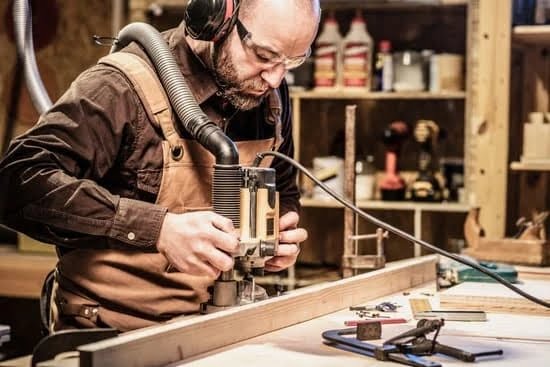Are you wondering how to make a workbench woodworking? A sturdy workbench is an essential piece of equipment for any woodworking enthusiast. Whether you are a beginner or an experienced woodworker, having a reliable workbench can make a significant difference in the quality and efficiency of your projects.
A workbench is not just a table where you can place your materials and tools – it is the foundation of your woodworking space. It provides a stable surface for cutting, sanding, assembling, and finishing your projects. In addition to being a functional workspace, a well-designed workbench can also offer storage solutions and provide support for heavy-duty tasks.
In this article, we will explore the different aspects of building a workbench. From choosing the right materials and designing the workbench to step-by-step instructions for construction and adding essential features, we will guide you through the process of creating a workbench that meets your specific woodworking needs.
Whether you have limited space or extensive requirements, we will help you build a workbench that suits your workshop perfectly. So let’s get started on creating the ultimate woodworking workspace.
Choosing the Right Materials
When it comes to building a sturdy workbench for woodworking, choosing the right materials is crucial. The materials you select will determine the durability and strength of your workbench, so it’s important to explore different options before making a decision. Here are some key considerations when choosing materials for your workbench:
- Wood: Many woodworkers prefer using hardwood such as oak, maple, or birch for their workbenches due to their strength and resistance to wear and tear. Softwoods like pine can also be used, but they may not be as durable in the long run.
- Metal: While wood is a popular choice for workbench construction, metal can also be used to add stability and weight-bearing capacity. Steel or aluminum are commonly used metals for workbench frames and legs.
Once you have decided whether to use wood, metal, or a combination of both for your workbench, consider factors such as cost, availability, and the specific needs of your woodworking projects. Keep in mind that while wood offers a traditional look and feel, metal provides excellent support for heavy-duty tasks.
Ultimately, the material you choose will depend on your personal preferences and the type of woodworking projects you intend to tackle on your workbench. By carefully evaluating the pros and cons of each material option, you can make an informed decision that will result in a sturdy and reliable workbench for all your woodworking needs.
Designing the Workbench
Designing a workbench is an essential part of the woodworking process, as it needs to be tailored to fit your specific needs and space. The first step in designing your workbench is to consider the type of woodworking projects you will be working on.
For example, if you will be mainly working on small-scale projects, a compact workbench may be more suitable. On the other hand, if you will be working on larger projects, such as furniture making, you may need a larger workbench.
Another important consideration when designing your workbench is the available space in your workshop or garage. Take precise measurements to ensure that the workbench fits comfortably in the designated area. It’s also crucial to consider any obstacles or features in the space that could impact the design and functionality of your workbench.
When planning out the design of your workbench, think about the height that will suit you best for comfortable woodworking. A general rule of thumb is to have the work surface at a height that allows for minimal strain on your back and arms while working. Additionally, think about incorporating storage options into the design to keep your tools and materials organized and easily accessible while working on projects.
Once you have determined these key factors, sketch out a rough design before moving onto the construction phase. Consider different configurations for shelves, drawers, and tool racks based on what will serve you best in your woodworking tasks.
| Key Factors | Considerations |
|---|---|
| Type of Woodworking Projects | Small-scale vs. large-scale projects |
| Available Space | Measurements and potential obstacles in the workshop or garage |
| Work Surface Height | Comfortable height for minimal strain |
| Storage Options | Incorporating shelves, drawers, and tool racks into the design |
Tools Needed
When it comes to building a workbench for woodworking, having the right tools is crucial to ensure the construction process goes smoothly and efficiently. Here are some essential tools that you will need:
Measuring and Marking Tools
Before you start cutting any materials, accurate measurements and markings are essential. Items such as a tape measure, combination square, and marking knife will help ensure precision in your workbench construction.
Cutting Tools
To cut the wood or metal for your workbench, you will need tools such as a circular saw, handsaw, or jigsaw. A good set of sharp chisels will also be necessary for fine tuning joints or making small adjustments.
Assembly Tools
Once all the pieces are cut to size, assembly tools like a power drill with driver bits, hammer, screwdrivers, and clamps will be needed to put everything together. Having sturdy clamps for securing pieces while assembling can make a world of difference.
Finishing Tools
Lastly, when it comes time to add finishing touches to your workbench such as sanding and staining – having sandpaper, brushes or rags for the stain application, and a sealant will be key in giving your workbench a polished look.
By having these essential tools on hand, you’ll be well-equipped to tackle the construction of your workbench with confidence. Remember that using quality tools can make the construction process smoother and more enjoyable.
Step-by-Step Instructions
Building your own workbench for woodworking can be a satisfying and cost-effective project. Here’s a step-by-step guide on how to make a workbench for woodworking:
1. Gather Materials and Tools: Before you begin, gather all the necessary materials and tools. You’ll need wood or metal for the benchtop, legs, and frame, as well as screws, glue, and finishing materials. The tools required may include a circular saw, drill, clamps, measuring tape, level, and sandpaper.
2. Cutting the Materials: Start by cutting the wood or metal to the appropriate dimensions for the benchtop, legs, and frame according to your design. It’s essential to measure accurately and use a straight edge to ensure precise cuts.
3. Assembling the Frame: Once all the pieces are cut to size, begin assembling the frame of the workbench using screws and glue. Make sure everything is square and level before securing it in place.
4. Attaching the Benchtop: After the frame is complete, attach the benchtop using screws from underneath or through the sides. Ensure that it is securely fastened to provide a sturdy work surface.
5. Adding Finishing Touches: Finally, sand down any rough edges or surfaces, then apply your chosen finish such as stain or varnish to protect the wood from wear and tear.
By following these step-by-step instructions on how to make a workbench for woodworking, you can create a durable and customized workspace that meets your specific needs. With proper care and maintenance, your homemade workbench can last for many years of enjoyable woodworking projects.
Adding Essential Features
When it comes to woodworking, having a workbench that is not only sturdy but also functional is essential. In this section, we will discuss the various ways to enhance the functionality of your workbench by incorporating essential features such as vices, clamps, and other accessories.
Choosing the Right Vices and Clamps
One of the most important features to consider when building a workbench for woodworking is the type of vices and clamps to incorporate. Woodworking vices are typically used for holding down pieces of wood securely while cutting, drilling, or shaping them. There are various types of vices available, including front vices, end (tail) vices, and shoulder vices. It’s important to choose vices that are durable and well-suited for woodworking projects.
Essential Accessories
In addition to vices and clamps, there are other accessories that can enhance the functionality of your workbench. For example, bench dogs are indispensable for keeping your workpiece in place while planing or sanding. Adjustable stops can be attached to the surface of the workbench to provide support for longer pieces of wood. Other accessories such as holdfasts, bench hooks, and tool racks can also contribute to making your workbench more efficient and convenient for woodworking tasks.
Customizing Your Workbench
Depending on your specific woodworking needs, you may want to customize your workbench with additional features such as integrated power outlets for tools, built-in storage compartments for hardware and supplies, or even a built-in dust collection system. Customizing your workbench allows you to create a space that truly suits your individual requirements and enhances your overall woodworking experience.
By carefully considering how you work and what would make tasks easier will allow you make something truly suited to you.
Incorporating these essential features into your workbench will not only improve its functionality but also make woodworking tasks more efficient and enjoyable. Whether you’re using traditional hand tools or modern power tools in your workshop, having a well-equipped workbench will significantly impact the quality of your finished projects.
Finishing Touches
The finishing touches on a workbench are essential for not only giving it a professional appearance but also for protecting the wood from wear and tear. Sanding the workbench is the first step in achieving a smooth and even surface. Start with coarse-grit sandpaper to remove any rough spots or uneven areas, then gradually move to finer grits for a polished finish. This process prepares the wood to absorb the stain evenly and creates a smooth surface for sealing.
Staining your workbench can add both color and protection. Choose a wood stain that complements the rest of your woodworking space and apply it evenly across the entire workbench surface using a brush or cloth. Once dry, applying a sealant is crucial for protecting the wood from moisture, spills, and scratches. Polyurethane or varnish are common choices for sealing workbenches, providing a durable finish that can withstand frequent use.
In addition to sanding, staining, and sealing, adding some personal touches to your workbench can further enhance its appearance and functionality. Whether it’s customization with decals or simply adding hooks and storage compartments, these details can help make your workbench feel like a personalized workspace tailored to your woodworking needs.
| Finishing Touches | Tips on Sanding, Staining, and Sealing |
|---|---|
| Prepare the wood by sanding with different grits of sandpaper | Choose a wood stain that complements your workspace |
| Apply sealant such as polyurethane or varnish for protection | Add personal touches or customizations to enhance functionality |
Maintaining Your Workbench
A well-constructed workbench is an essential tool for any woodworking enthusiast. Once you have put in the effort to design and build your own workbench, it is important to maintain it properly to ensure its longevity and continued functionality. Proper maintenance not only extends the lifespan of your workbench but also ensures safety and efficiency while working on your projects.
To keep your workbench in top condition, it is important to regularly inspect it for any signs of wear and tear. Check for loose screws, cracks in the wood, or any damage to the surface. Addressing these issues promptly can prevent further deterioration and potential safety hazards. Additionally, keep an eye out for any rust or corrosion on metal components of the workbench, such as vices or clamps.
Regular cleaning is also crucial for maintaining a workbench. Dust and debris can accumulate on the surface and in crevices, which can affect the accuracy of your woodworking projects. Use a vacuum or brush to remove sawdust, shavings, and other debris from your workbench after each use. For stubborn residue, a mild detergent or wood-safe cleaning solution can be used followed by thorough drying.
Furthermore, protecting your workbench from environmental factors can significantly prolong its lifespan. If your work area is prone to high humidity or temperature fluctuations, consider using a dehumidifier or air conditioning to regulate the climate around your workbench. Additionally, applying a protective coating such as wax or polyurethane can help safeguard the wood from moisture and prevent warping or splitting over time.
By implementing these maintenance practices, you can ensure that your custom-built workbench remains in optimal condition for years of woodworking projects. Regular inspections, cleaning, and protection from environmental factors will allow you to continue enjoying the benefits of having a sturdy and reliable workspace for all your woodworking endeavors.
Conclusion
In conclusion, a well-constructed workbench is truly the backbone of any woodworking space. By following the right steps and using the proper materials, you can create a sturdy and reliable workbench that will enhance your woodworking experience. From choosing the right wood or metal to adding essential features like vices and clamps, every aspect of building a workbench is crucial in ensuring its functionality.
The satisfaction of building your own woodworking workspace cannot be overstated. Not only does it allow you to customize the design according to your specific needs and space, but it also gives you a sense of accomplishment and pride knowing that you built an essential tool for your craft. With the right tools and step-by-step instructions, anyone with a passion for woodworking can successfully build their own workbench.
In closing, maintaining your workbench is key to prolonging its lifespan and ensuring its continued functionality. By incorporating regular maintenance routines into your woodworking schedule, you can keep your workbench in top condition for years to come. Whether you are a seasoned woodworker or just starting out, having a well-constructed workbench will undoubtedly elevate your woodworking projects and make the process more enjoyable and efficient.
Frequently Asked Questions
Is It Cheaper to Build a Workbench?
Building a workbench can be cheaper than buying one, especially if you already have some of the necessary materials on hand. By sourcing affordable lumber and using basic tools, you can create a sturdy workbench at a lower cost compared to purchasing one from a store.
What Type of Wood Should I Use for a Workbench?
When choosing wood for a workbench, it’s important to prioritize durability and strength. Hardwoods like oak, maple, or birch are excellent choices due to their resilience and load-bearing capacity. However, if cost is a concern, opting for construction-grade softwood like Douglas fir or Southern yellow pine can still provide adequate sturdiness for your workbench.
How Many 2×4 Do I Need for a Workbench?
The number of 2x4s needed to build a workbench will depend on the size and design of the bench. Typically, a simple workbench may require around six to eight 8-foot long 2x4s for the legs and framing. Additionally, you may need more 2x4s if you choose to add extra features such as shelves or additional bracing for increased stability.

Hi everyone! I’m a woodworker and blogger, and this is my woodworking blog. In my blog, I share tips and tricks for woodworkers of all skill levels, as well as project ideas that you can try yourself.





